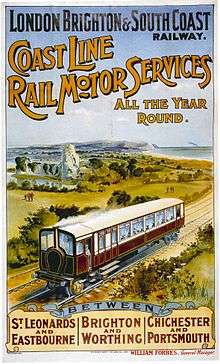Railmotor

Railmotor is a term which was used by several British railway companies for a lightweight railcar, that is, a railway carriage with a small steam traction unit or diesel or petrol engine integrated into it.
Steam railcars
Overview

In the earliest days of railways, designers wished to produce a vehicle for passenger carrying that was economical to build and operate on routes where passenger numbers were light. A single coach with its own prime mover was a solution adopted in some cases; this may be thought of as the predecessor to the railcar, a term more associated with the use of internal combustion engines.
William Bridges Adams started building railmotors in small numbers as early as 1848. The Bristol and Exeter Railway used a steam carriage.
In most cases the early designs were unsuccessful technically, but in the early years of the twentieth century, street-running passenger tramways started to use small steam engines to draw tramcars, replacing the customary horse traction. In many cases the tramways soon adopted electric traction instead, and the attractiveness of the cheap and frequent conveyance abstracted business from the railways in urban areas.
The railways responded by opening new stopping places (to serve more closely the new suburban housing) and sought to reduce their operating cost by reintroducing railmotors, which were cheaper to construct.
The London and North Western Railway, Lancashire and Yorkshire Railway, London Brighton and South Coast Railway and Great Western Railway introduced them.
Nonetheless the railmotors had a number of disadvantages: their frequency, and the closeness of their stopping places, could not match that of the tramcars. The intrinsic compromises in fitting a steam engine inside the limited space available made them mechanically inefficient, and their power was (in most designs) insufficient to handle attached vehicles for parcels or additional coaches at times of exceptional demand such as public holidays; and in nearly all cases they still required a three-man crew (driver, fireman and guard), a significant expense compared with the single crew member of a tramcar.
Designs
.jpg)
There were two basic designs:
- A small 0-4-0 or 0-2-2 steam locomotive with one end of a coach hung on it like an articulated lorry.
- A coach with a steam engine built into one end of it. This type would sometimes have a vertical boiler.
These machines were not a great success because they lacked flexibility. Most could haul a single trailer, but no more. This meant they were unable to cope with greater than expected passenger demands – a classic example being busy market days on an otherwise lightly used rural branch line. They were also unable to haul goods wagons, requiring a conventional locomotive to be stationed on the same line in any case for these duties. For this reason, they were largely superseded by push-pull trains and the GWR converted some of their railmotors into autocoaches for this purpose. The South Eastern & Chatham Railway built its P Class of small, light tank locomotives specifically to replace railmotors in the 1900s.
.jpg)
In the late 1920s there was another revival of railmotors with the introduction of new designs from Clayton and Sentinel with high-speed motors and geared drive. The London and North Eastern Railway bought over 80 of them but, again, they were short-lived. Some lasted no more than 10 years and all had been withdrawn by 1947.
From the 1930s the diesel railcar made great progress and by the 1950s the railmotor was consigned to history. The diesel's ability to use multiple unit control was an advantage.
Heritage examples
The Great Western Society, based at Didcot, has restored a Great Western Railway steam railmotor, built in 1908 to working condition. It regularly operates throughout the summer and has visited other preserved railways in the west country and Wales. It also operated on the mainline between Liskeard and Looe in November 2012.
The heritage Downpatrick and County Down Railway (D&CDR), Northern Ireland, owns an example of a Belfast and County Down Railway railmotor which was converted to an autotrain driving trailer while in service. After withdrawal it was used as private accommodation in a field but has now been restored to working order. The D&CDR also has Great Southern and Western Railway No. 90, which was built in 1875 as a railmotor but had its carriage portion removed in 1915.
Fleets
See also
References
- ↑ Metropolitan Amalgamated Railway Carriage and Wagon Company Ltd drawing no. 12640
- ↑ CSAR General Manager's Reports, Extracts from the CSAR General Manager's Reports for 1906, 1907, 1908 & 1909.
- ↑ "The Sentinel Steam Railcars". LNER Encyclopedia. Retrieved 21 September 2012.
- ↑ Clayton Steam Rail Coach - From the Dave Rhind Collection, Railway History Group of South Africa, Pinelands, Cape Town.
- ↑ The Combined Engines and Cars of South Australia Eardley, Gifford Australian Railway Historical Society Bulletin, April, 1978 pp79-82
- Dempsey, G Drysdale (1857). "Extracts from a Rudimentary Treatise on the Locomotive Engine". Broadsheet (reprinted from book). Broad Gauge Society (55): 24–26.
- Kichenside, G.M. (1964). Railway Carriages, 1839-1939. London: Ian Allan.
- Parkhouse, Niel; Pope, Ian. "The Rise and Fall of the Steam Rail Motor". Archive. Lightmoor Press (3): 39–46. ISSN 1352-7991.
- Mountford, Eric R (1987). The Barry Railway, Diagrams and photographs of Locomotives, Coaches and Wagons. Oxford: Oakwood Press.